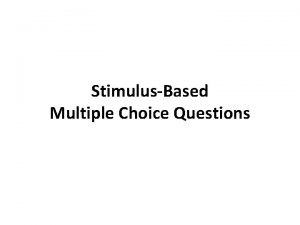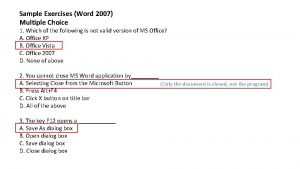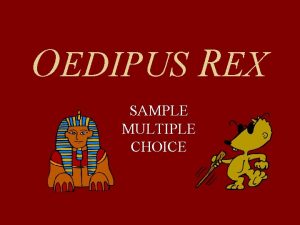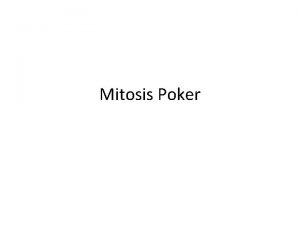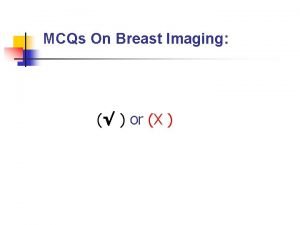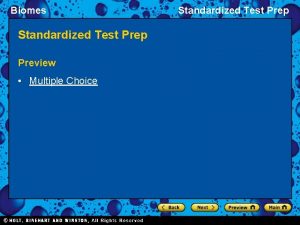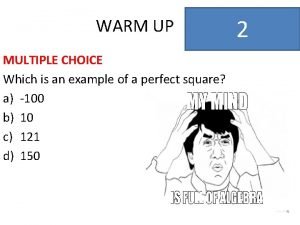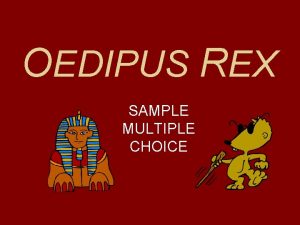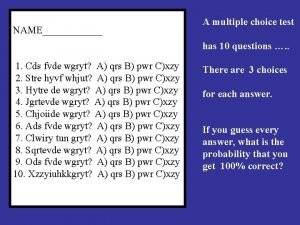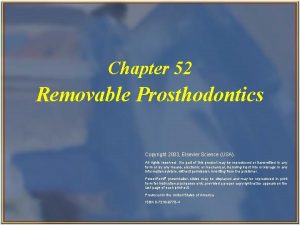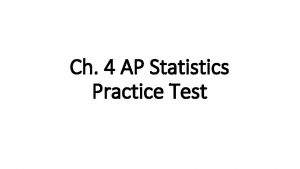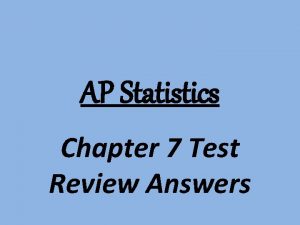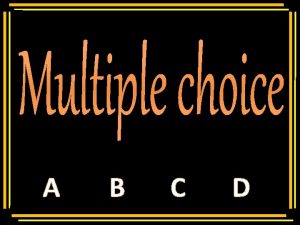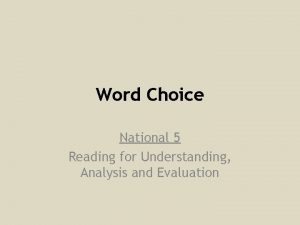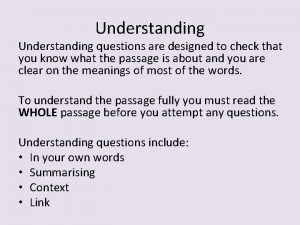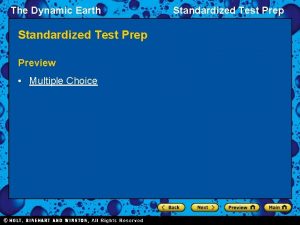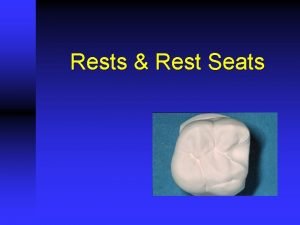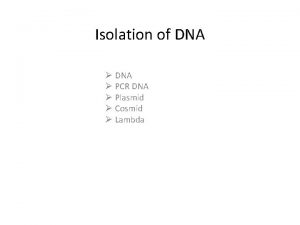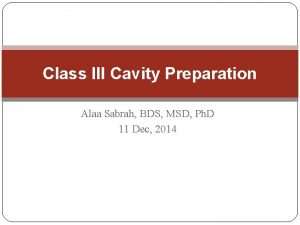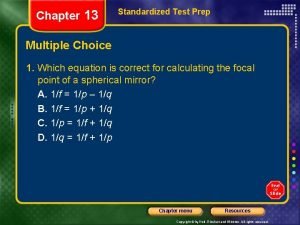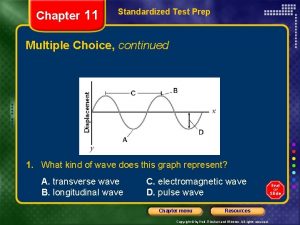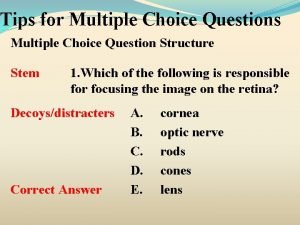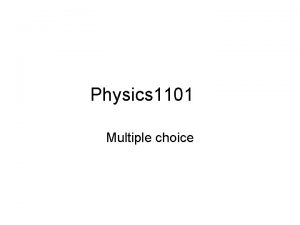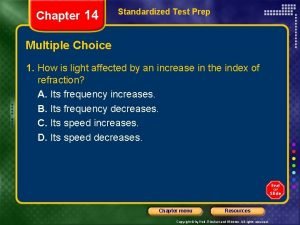Oxford MAT Prep Multiple Choice Questions Dr J






















































































































- Slides: 118

Oxford MAT Prep: Multiple Choice Questions Dr J Frost (jfrost@tiffin. kingston. sch. uk) www. drfrostmaths. com Copyright Notice: This resource is free-to-use for all NOT FOR PROFIT contexts only. I do not give permission for them to be used in any context involving financial gain, notably by private tutors or Oxbridge preparation agencies. Last Updated: 28 th January 2016

Index Click to go to the corresponding section. Comparing Values Sequences Trapezium Rule Number Theory Area/Perimeter Remainder Theorem Logarithms Circles Graph Sketching Calculus Reasoning about Solutions Trigonometry

General Points 1. 2. 3. 4. 5. 6. 7. The Oxford MAT paper is the admissions test used for applicants applying to Oxford for Mathematics and/or Computer Science, or to Mathematics at Imperial. It consists of two sections. The first is multiple choice, consisting of 10 questions each worth 4% each (for a total of 40%). The second consists of 4 longer questions, each worth 15% (for a total of 60%). We deal with the first section here. The paper is non-calculator. You need roughly 50% to be invited for interviews. However, successful maths applicants have an average of around 75%. The questions only test knowledge from C 1 and C 2. You must ensure you know the content of these two modules inside out. You should also keep in mind that the MAT won’t test you on theory you wouldn’t have covered, so should think in the context of what you can be expected to do. The multiple choice questions become progressively easier (and quicker) the more you practise. So practise these papers regularly. Even redoing a paper you’ve done before has value. I’ve grouped some of the questions from these papers here by topic, to help you spot some of the common strategies you can use.

Comparing Values Preliminary Tips

Comparing values A B C D

Key Points

Comparing values A B C D

Key Points

Comparing values A B C D

Key Points

Comparing values A B C D

Sequences Preliminary Tips

Sequences A 2011 B C D

Key Points

Sequences A 2010 B C D

Key Points 1. If you have two interweaved sequences, find formulae for them separately. This means we just want the sum of the first n terms from each of the two. 2. Know your formulae for the sum/infinite sum of a geometric series like the back of your hand.

Sequences A 2009 B C D

Key Points 1. Sometimes it helps to think about the ‘running total’ as we progress along the sum. Our cumulative totals here are 1, -1, 2, -2, 3, -3, … 2. Alternatively, try to spot when you can pair off terms such that things either cancel or become the same. In this case, 1 -2 = -1, 3 -4=-1, and so on. Although this makes it harder to spot exactly when we hit 100 in this case. 3. Think carefully about what happens at the end. Looking at the running totals, if the 1 st is 1, the 3 rd is 2, the 5 th 3, then the (2 n-1)th gives us n. So when our running total was 100, 2 n-1 = 199.

Trapezium Rule Preliminary Tips Overestimates when line curves upwards. Underestimates when line curves downwards.

Trapezium Rule 2010 A B C D

Key Points

Trapezium Rule A 2009 B C D

Key Points

Trapezium Rule A 2008 B C D

Key Points 1. Thinking about the question visually helps. A function which curves upwards will give an overestimate, and a function which curves downwards gives an underestimate. 2. (d) is the only transform which changes the shape of the curve, giving us a reflection on the y-axis (in the line y=1). A curve for example curving up will now curve down, giving us an underestimate.

Number Theory Preliminary Tips

Number Theory A 2008 B C D

Key Points

Number Theory A 2008 B C D

Key Points

Number Theory A 2009 B C D

Key Points

Number Theory A 2007 B C D

Number Theory A 2010 B C D

Area/Perimeter Preliminary Tips 1 1 r The radius of the big circle is 1. What is the radius of the small circle? ?

Area/Perimeter A 2012 B C D

Key Points

Area/Perimeter A 2012 B C D

Key Points

Area/Perimeter A 2011 B C D

Key Points

Area/Perimeter A 2006 B C D

Key Points

Remainder Theorem Preliminary Tips

Remainder Theorem A 2008 B C D

Remainder Theorem A 2006 B C D

Remainder Theorem A 2009 B C D

Key Points

Logarithms Preliminary Tips

Logarithms A 2011 B C D

Key Points

Logarithms A 2007 B C D

Key Points

Circles Preliminary Tips The nearest point to this dot on the circumference of the circle can be found by drawing this straight line from the centre. Nearest points to each other.

Circles A 2012 B C D

Key Points

Circles A 2011 B C D

Key Points

Circles A 2009 B C D

Key Points (-3, -4) 1. As per usual, complete the square, and then a sketch may help. 2. By inspection, we can see the nearest point to the origin must be on the line that goes from the centre and through the origin. 3. Since the radius is 10 and the distance from the centre to the origin is 5 (by Pythagoras), then the answer must be 5.

Circles A 2007 B C D

Key Points 1. Again, draw a diagram! 2. Drawing a line between the centres of the circles often helps for questions like these. We can see visually that the nearest point must lie on this line.

Circles A 2006 B C D

Graph Sketching Preliminary Tips

Graph Sketching A 2011 B C D

Key Points

Graph Sketching A 2008 B C D

Key Points

Graph Sketching A 2007 B C D

Key Points

Graph Sketching A 2010 B C D

Key Points

Graph Sketching A 2012 B C D

Key Points

Calculus Preliminary Tips

Calculus A 2009 B C D

Key Points

Calculus A 2012 B C D

Key Points 1. You don’t need to actually do any integration here (and you won’t be able to unless you’ve done C 3!) 2. Looking at the multiple choice options, we only care if T is positive/negative/0. 3. Thus for each of the integrals, we only care whether the area under the graph is above the x-axis or below the x-axis. 4. By sketching the 3 graphs, we find the first area is positive, the second negative and the third positive. Thus T is negative.

Calculus A 2011 B C D

Key Points

Calculus A 2010 B C D

Key Points

Calculus A 2008 B C D

Calculus A 2007 B C D

Key Points

Calculus Important Note: This question is sufficiently old that it was before the ‘C’ modules existed at A Level (instead of C 1 -4 and FP 1 -3, there was P 1 -6). This kind of content would now appear in C 3, and thus a question like this would no longer appear in a MAT. A 2006 B C D

Reasoning about Solutions Preliminary Tips There’s three ways to consider the number of solutions: METHOD 1: Factorise (when possible!) METHOD 3: Consider the discriminant METHOD 2: Reason about the graph

Reasoning about Solutions Preliminary Tips More on METHOD 2: Reason about the graph

Reasoning about Solutions A 2009 B C D

Key Points

Reasoning about Solutions A 2009 B C D

Key Points

Reasoning about Solutions A 2008 B C D

Key Points

Reasoning about Solutions A 2007 B C D

Key Points

Reasoning about Solutions A 2006 B C D

Key Points Now it’s clear there’s no solutions.

Trigonometry Preliminary Tips

Trigonometry A 2007 B C D

Key Points

Trigonometry A 2008 B C D

Key Points

Trigonometry A 2009 B C D

Key Points

Trigonometry A 2011 B C D

Key Points

Trigonometry A 2010 B C D

Key Points

Trigonometry A 2008 B C D

Key Points

Trigonometry A 2011 B C D

Key Points

Trigonometry A 2011 B C D

Key Points • It’s helpful to draw out the two graphs on the same axis, and then shade the appropriate regions.

Trigonometry A 2011 B C D

Key Points
 How to write multiple choice questions
How to write multiple choice questions A second daniel merchant of venice
A second daniel merchant of venice The story of an hour simile
The story of an hour simile Stimulus based multiple choice questions
Stimulus based multiple choice questions Conjunctive adverbs quiz
Conjunctive adverbs quiz How to create multiple choice questions in word 2007
How to create multiple choice questions in word 2007 Stimulus-based questions examples
Stimulus-based questions examples Astronomy questions and answers multiple choice
Astronomy questions and answers multiple choice What is the main purpose of persuasive paragraph mcq
What is the main purpose of persuasive paragraph mcq The plot of oedipus deals mainly with
The plot of oedipus deals mainly with Multiple choice questions on shakespeare sonnets
Multiple choice questions on shakespeare sonnets Mitosis
Mitosis Mammography mcq questions with answers
Mammography mcq questions with answers Growth mindset multiple choice questions
Growth mindset multiple choice questions Biomes multiple choice questions with answers
Biomes multiple choice questions with answers Ap lang mcq
Ap lang mcq Alteryx advanced certification prep
Alteryx advanced certification prep Multiple choice questions on ecotourism
Multiple choice questions on ecotourism Which command is used to set terminal io characteristic
Which command is used to set terminal io characteristic Tone multiple choice questions
Tone multiple choice questions Multiple choice questions on photoelectric effect
Multiple choice questions on photoelectric effect Multiple choice questions on flowering plants
Multiple choice questions on flowering plants Vignette-style multiple choice questions
Vignette-style multiple choice questions Abolitionist movement ap world history
Abolitionist movement ap world history Conjunction questions
Conjunction questions Pleomorphism in chicken pox
Pleomorphism in chicken pox Quadratic equations mcq
Quadratic equations mcq Multiple choice questions on poetic devices
Multiple choice questions on poetic devices Direction for multiple choice test
Direction for multiple choice test Aqa economics multiple choice questions
Aqa economics multiple choice questions Multi choose
Multi choose How can kinetic energy help a rescue team
How can kinetic energy help a rescue team Multiple choice questions on dna structure and replication
Multiple choice questions on dna structure and replication The plot of oedipus deals mainly with
The plot of oedipus deals mainly with Multiple choice questions
Multiple choice questions The scientist who discovered m. tuberculosis was: *
The scientist who discovered m. tuberculosis was: * Multiple choice questions on prokaryotes and eukaryotes
Multiple choice questions on prokaryotes and eukaryotes Multiple choice questions
Multiple choice questions Eucharist multiple choice questions
Eucharist multiple choice questions Multiple choice questions
Multiple choice questions Economics multiple choice questions aqa
Economics multiple choice questions aqa Examples of distractors in multiple-choice questions
Examples of distractors in multiple-choice questions The chaser john collier questions
The chaser john collier questions Silk road multiple choice questions
Silk road multiple choice questions Positive psychology multiple choice questions
Positive psychology multiple choice questions Pacemaker multiple choice questions
Pacemaker multiple choice questions Good choice or bad choice
Good choice or bad choice Binary choice items
Binary choice items Ap comp sci
Ap comp sci Ap lit practice test multiple-choice
Ap lit practice test multiple-choice Soal pilihan ganda (multiple choice)
Soal pilihan ganda (multiple choice) Graphic text examples osslt
Graphic text examples osslt Chapter 56 oral and maxillofacial surgery multiple choice
Chapter 56 oral and maxillofacial surgery multiple choice Introduction to prosthodontics
Introduction to prosthodontics Chapter 52 removable prosthodontics short answers
Chapter 52 removable prosthodontics short answers Copyright
Copyright Chapter 37 vital signs and measurements
Chapter 37 vital signs and measurements When we take a census we attempt to collect data from
When we take a census we attempt to collect data from Polynomials multiple choice test doc
Polynomials multiple choice test doc Hsc multiple choice practice
Hsc multiple choice practice Dental hand instruments chapter 34
Dental hand instruments chapter 34 Todays with apostrophe
Todays with apostrophe Who disturbed the watch of the elsinore guards
Who disturbed the watch of the elsinore guards Data dictionary ipt
Data dictionary ipt Chapter 59 dental sealants multiple choice
Chapter 59 dental sealants multiple choice Chapter 30 milady
Chapter 30 milady Multiple choice choose the best answer
Multiple choice choose the best answer Ap stats chapter 7 review
Ap stats chapter 7 review Math multiple choice test taking strategies
Math multiple choice test taking strategies Accounting final exam review
Accounting final exam review Beyond multiple choice
Beyond multiple choice Antigone final test review
Antigone final test review Chapter 5 elasticity and its application multiple choice
Chapter 5 elasticity and its application multiple choice Multiple choice a b c d
Multiple choice a b c d Multiple choice pencil
Multiple choice pencil Multiple baseline vs multiple probe design
Multiple baseline vs multiple probe design Multiple instruction multiple data
Multiple instruction multiple data How to answer word choice questions national 5
How to answer word choice questions national 5 Word choice questions
Word choice questions What is forced choice questions
What is forced choice questions Performance management ppt
Performance management ppt Word choice questions examples
Word choice questions examples What is forced choice questions
What is forced choice questions Higher english close reading
Higher english close reading Saucer shaped rest seat
Saucer shaped rest seat Test prep preview
Test prep preview Ideal class 3 prep cdca
Ideal class 3 prep cdca Swap prep for he
Swap prep for he Sterile gloves
Sterile gloves Prep and drape
Prep and drape Stanford achievement test sample questions grade 1
Stanford achievement test sample questions grade 1 Test prep preview
Test prep preview Test prep preview
Test prep preview Test prep preview
Test prep preview Rests and rest seats
Rests and rest seats Multiplicom library prep
Multiplicom library prep Usatestprep create account
Usatestprep create account Isthmus width is 1/4th intercuspal distance
Isthmus width is 1/4th intercuspal distance Nocti test answers
Nocti test answers Ncprepswim
Ncprepswim Trichomonas prep pmn
Trichomonas prep pmn Circuit training standardized test prep answers
Circuit training standardized test prep answers Lutz preparatory school lottery
Lutz preparatory school lottery Lunchable snack duos
Lunchable snack duos Jones college prep uniform
Jones college prep uniform Mini prep
Mini prep Marketo user group new york
Marketo user group new york Test prep preview
Test prep preview Tunnel preparation in dentistry
Tunnel preparation in dentistry Fache practice exam
Fache practice exam Mini prep
Mini prep Glacier tax prep gtp
Glacier tax prep gtp Comlex question bank
Comlex question bank Crown down vs step back
Crown down vs step back Class 3 cavity preparation
Class 3 cavity preparation Chapter 21 standardized test practice answers
Chapter 21 standardized test practice answers Chapter 13 standardized test practice answers
Chapter 13 standardized test practice answers Chapter 11 standardized test practice
Chapter 11 standardized test practice Bradford prep
Bradford prep



